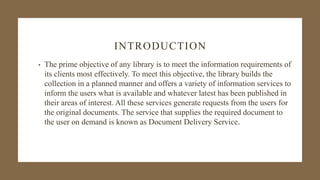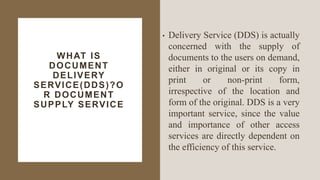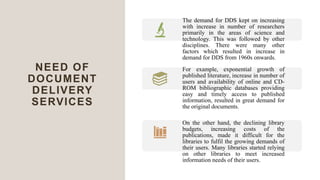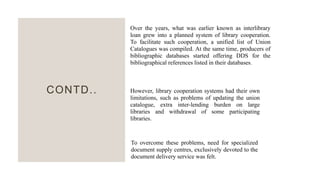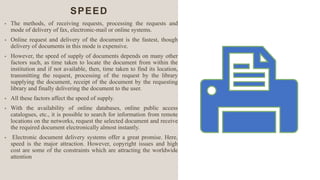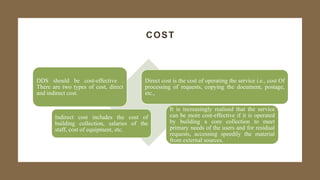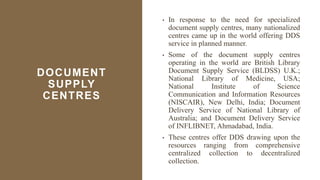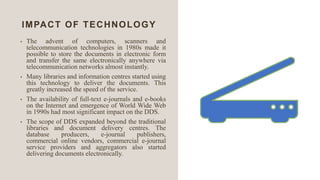DDS.pptx
- 2. INTRODUCTION • The prime objective of any library is to meet the information requirements of its clients most effectively. To meet this objective, the library builds the collection in a planned manner and offers a variety of information services to inform the users what is available and whatever latest has been published in their areas of interest. All these services generate requests from the users for the original documents. The service that supplies the required document to the user on demand is known as Document Delivery Service.
- 3. WHAT IS DOCUMENT DELIVERY SERVICE(DDS)?O R DOCUMENT SUPPLY SERVICE • Delivery Service (DDS) is actually concerned with the supply of documents to the users on demand, either in original or its copy in print or non-print form, irrespective of the location and form of the original. DDS is a very important service, since the value and importance of other access services are directly dependent on the efficiency of this service.
- 4. CONTD.. • Online Dictionary of Library and Information Science defines DDS as “Provision of published or unpublished documents in hardcopy, microform, or digital format, usually, for a fixed fee upon request.”
- 5. GROWTH AND DEVELOPMEN T • Earlier, the DDS was limited to the lending of required documents to the user for a specified period of time by the library from its own collection and if not available within the library, then borrowing it from other libraries on interlibrary loan and lending it to the user. With the introduction of xerography in mid 1950s and large scale use of photocopiers in libraries by 1970s, the DDS was not just confined to the lending of documents, but documents could be duplicated and permanently given to the users. The libraries started using photocopiers to supply copies of the required documents, such as journal article or a few pages of books for DDS purposes
- 6. NEED OF DOCUMENT DELIVERY SERVICES The demand for DDS kept on increasing with increase in number of researchers primarily in the areas of science and technology. This was followed by other disciplines. There were many other factors which resulted in increase in demand for DDS from 1960s onwards. For example, exponential growth of published literature, increase in number of users and availability of online and CD- ROM bibliographic databases providing easy and timely access to published information, resulted in great demand for the original documents. On the other hand, the declining library budgets, increasing costs of the publications, made it difficult for the libraries to fulfil the growing demands of their users. Many libraries started relying on other libraries to meet increased information needs of their users.
- 7. CONTD.. Over the years, what was earlier known as interlibrary loan grew into a planned system of library cooperation. To facilitate such cooperation, a unified list of Union Catalogues was compiled. At the same time, producers of bibliographic databases started offering DDS for the bibliographical references listed in their databases. However, library cooperation systems had their own limitations, such as problems of updating the union catalogue, extra inter-lending burden on large libraries and withdrawal of some participating libraries. To overcome these problems, need for specialized document supply centres, exclusively devoted to the document delivery service was felt.
- 8. EFFICIENCY OF DOCUMENT DELIVERY SERVICE DDS should be cost-effective, speedily delivered and satisfying all the requests it receives. Satisfaction level. Cost and Speed, The efficiency of DDS is determined by three factors, namely,
- 9. SPEED • The methods, of receiving requests, processing the requests and mode of delivery of fax, electronic-mail or online systems. • Online request and delivery of the document is the fastest, though delivery of documents in this mode is expensive. • However, the speed of supply of documents depends on many other factors such, as time taken to locate the document from within the institution and if not available, then, time taken to find its location, transmitting the request, processing of the request by the library supplying the document, receipt of the document by the requesting library and finally delivering the document to the user. • All these factors affect the speed of supply. • With the availability of online databases, online public access catalogues, etc., it is possible to search for information from remote locations on the networks, request the selected document and receive the required document electronically almost instantly. • Electronic document delivery systems offer a great promise. Here, speed is the major attraction. However, copyright issues and high cost are some of the constraints which are attracting the worldwide attention
- 10. COST DDS should be cost-effective . There are two types of cost, direct and indirect cost. Direct cost is the cost of operating the service i.e., cost Of processing of requests, copying the document, postage, etc., Indirect cost includes the cost of building collection, salaries of the staff, cost of equipment, etc. It is increasingly realised that the service can be more cost-effective if it is operated by building a core collection to meet primary needs of the users and for residual requests, accessing speedily the material from external sources.
- 11. SATISFACTION LEVEL DDS should target at satisfying all the requests it receives for the supply of the documents. A high satisfaction level depends not only on the availability of the required document in the centre that offers the service but also on the ability of the centre to locate and supply it from elsewhere in the world as quickly as possible.
- 12. M O D E O F D O C U M E N T D E L I V E RY S E RV I C E • Document Delivery means supplying documents ( Copies in print or digital format) are delivered through mail/ courier or other way. Document delivery to end users implies three types of operations • Document identification • Document location • Document procurement
- 13. DOCUMENT IDENTIFICATION • It requires the bibliographical details of the documents such as author, article title, source, volume, and pages correctly in a given format. User can verify such details by searching the web or the relevant databases.
- 14. DOCUMENT LOCATION • It identifying the library holdings the documents under reference. User may search using union catalogues available form library networks
- 15. DOCUMENT PROCUREMENT • It implies writing to the relevant libraries service providers for delivery documents. There are several modes of documents procurement • Requesting documents from the holding library/library networks • Requesting documents from document delivery service providers • Searching the web for digital copies of the documents for free access
- 16. DOCUMENT SUPPLY CENTRES • In response to the need for specialized document supply centres, many nationalized centres came up in the world offering DDS service in planned manner. • Some of the document supply centres operating in the world are British Library Document Supply Service (BLDSS) U.K.; National Library of Medicine, USA; National Institute of Science Communication and Information Resources (NISCAIR), New Delhi, India; Document Delivery Service of National Library of Australia; and Document Delivery Service of INFLIBNET, Ahmadabad, India. • These centres offer DDS drawing upon the resources ranging from comprehensive centralized collection to decentralized collection.
- 17. IMPACT OF TECHNOLOGY • The advent of computers, scanners and telecommunication technologies in 1980s made it possible to store the documents in electronic form and transfer the same electronically anywhere via telecommunication networks almost instantly. • Many libraries and information centres started using this technology to deliver the documents. This greatly increased the speed of the service. • The availability of full-text e-journals and e-books on the Internet and emergence of World Wide Web in 1990s had most significant impact on the DDS. • The scope of DDS expanded beyond the traditional libraries and document delivery centres. The database producers, e-journal publishers, commercial online vendors, commercial e-journal service providers and aggregators also started delivering documents electronically.
- 18. E L E C T R O N I C D O C U M E N T D E L I V E RY S Y S T E M S • The systems employing electronic technology for receipt of requests and supply of documents electronically over telecommunication networks are called Electronic Document Delivery Systems (EDDS). • This technology uses series of devices that scan paper copy of the document, capture the document image and store it in digital format. • The digital copy of the document is sent electronically via e-mail, fax or other document delivery software like “Ariel” to the requester. • Online Dictionary of Library and Information Science defines Electronic Document Delivery as “The transfer of information traditionally recorded in physical medium (print, videotape, sound recording, etc.) to the user electronically via e-mail or World Wide Web. • The libraries employ digital technology to deliver the information contained in the documents and files placed on reserve and requested via inter library loan.”
- 19. E M E R G E N C E O F E - J O U R N AL C O N S O R T I A • At present most of the scholarly peer reviewed journal are available in print as well in electronic form. E-journals, with built in search facilities, multimedia capability and remote access, are in great demand by the library users. • But ever shrinking budget of the libraries and exponential growth of e-publications and their escalating cost are making it difficult for individual library to meet this demand. So, many libraries are joining to form a consortium for subscription to ejournals. With Internet access to e-journal, a user can search and browse table of content of a journal, view abstract of the selected article and if desired can browse and download the full-text article instantaneously on his/her computer.
- 20. CONTD… • Consortium based subscription to e- journals and electronic full text databases are picking up by libraries in India. • At present over 10 national level consortia are operating in the country. • Some of them are INDEST-AICTE Consortium, UGC-INFONET Digital Library Consortium, and National Knowledge Resource Consortium of e- resources of CSIR and DST. This has resulted in lesser demand for printed journal articles. Because of e-Journal consortia, most of the document supply centres are witnessing decrease in demand for delivery of documents, particularly of journal articles
- 21. ELECTRONIC DOCUMENT DELIVERY SYSTEMS (EDDS) – EXAMPLES EDDS systems provide immediate access to the needed information. In such systems, the request may be received by telephone, e-mail, Fax or online. The document is sent electronically via email, or other document delivery software like Ariel. EDDS can provide immediate access to the material. Apart from speed, it is convenient to access the information for which EDDS are preferred over traditional document delivery methods. Ariel Interlibrary Loan Software is an Internet document transmission system owned and supported by Infotrieve Inc. It is used by a large number of libraries around the world for electronic document delivery purposes. Ariel software permits user to scan, store, transmit, and print material. With Ariel software, an article in a print journal can be scanned into PC and image transmitted over the Internet to other Ariel workstations anywhere in the world.
- 22. CONCLUSION • Document Delivery Services provides the pinpointed, proper and very quick service to the user. Document delivery service is dm culminating point of all the access services and plays a vital role in information access and dissemination. While other library services help the user to identify the document he needs, this service actually locates the document and delivers it to the user. Modem computers and telecommunication technologies are exerting great impact on document delivery systems. Emergence of CD- ROM as the cheapest storage medium for large Volume storage, has resulted in the production of a large number of full-text databases on CD-ROM which are increasingly being used for document delivery purposes. The integration of online, CD-ROM and fax technologies have set new high-tech trends in document delivery. Electronic' Document Delivery Systems are emerging which facilitate online searching, online ordering and online delivery of document.

